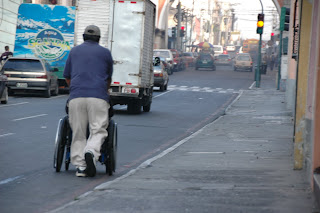 s a beautiful face and bright eyes that manage to laugh despite the physical and emotional pain.
s a beautiful face and bright eyes that manage to laugh despite the physical and emotional pain.Jesse and I followed with our Panasonic HVX hi-def cameras and we had Aaron with us, a friend we met last night. We gave Aaron the Nikon and let him go to work getting photographs for the website and future print pieces. Papa wheeled Tanya through the very narrow corridor on which they live. That empties out onto a wider alleyway. He took that down to the river and then followed the main road out of La Limonada. The main road goes up. It’s the only way to go. Papa doesn’t work as a painter anymore because he has such a sore hip. Picture him pushing Tanya in her wheelchair up a very, very steep hill. (Papa was so exhausted at one point that the film crew jumped in and pushed Tanya the rest of the way up the hill.)
Once at the top, traffic is the main enemy. Cars and trucks and buses fly by. Diesel fumes and smoke hang thick in the air. Papa and Tanya quickly and deftly maneuver through it. They do this every day and are quite good at it. The streets are level for several blocks, then go up again. The traffic in
So the work day began. She joked around and laughed with the flower vendor on the corner. They must see each other each day there on the corner. And she wheeled herself up and down that incredibly busy intersection in her low, blue chair, reachi
We shot this scene from a variety of angles. Sometimes when you see life unfold through a lens, rather than just watching it with the naked eye as you pass by, you see things differently. What I saw was how incredibly vulnerable Tanya is. That tiny chair, with Tanya in it, next to rumbling buses, diesel trucks, expensive cars and beat-up junkers. Some reach their hands out and place some coins—or paper bills—in the cup. Others ignore her. Others literally don’t see her. This is her life. She does this each and every day because she has to to survive.
By seeing the behind-the-scenes story of this one beggar on a street corner, I and my team have had our perspective changed of beggars in general. It the future, It will be mighty hard to see someone working a street corner in the Developing World and not immediately think of Tanya. We’ll wonder what the story is, who the Papa is, how much do they need to survive, what kind of room do they sleep in.
Getting to know one person has made me aware of a whole class of people.
That’s what this documentary is about. Maybe if viewers get to know a few slum dwellers, li
All one billion of them.
(photos for this posting: thanks to Aaron Kreuger.)

No comments:
Post a Comment